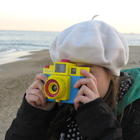Rome - architecture (page 2)
 |
The Trevi Fountain | The Trevi Fountain (Fontana di Trevi) is the most famous fountain in Rome. It replaced the fountain designed by Leon Battiste Alberti. The fountain we can admire nowadays was designed by Niccolo Salvi who got commissioned for this project even though great Giovanni Lorenzo Bernini also proposed his ... |
 |
 |
Baths of Caracalla | The Baths of Caracalla (Terme di Caracalla in Italian) were the largest public baths in Rome. They are located in Regio XII in the city of Rome. The water was supplied by the Aqua Marcia aqueduct.The public baths were constructed during the reign of Marco Aurelio Antonino Basiano Emperor, also know... |
 |
 |
The Colosseum | The Colosseum is one of the most famous amphitheaters in the world, is located in the center of Rome between the Basilica of the Lateran, and the Roman Forum. The construction of the Colosseum began between 70 and 72 AD and the opening ceremony took place in 80 AD. At the time the Rome was under the... |
 |
 |
The Spanish Stairs | The Spanish Stairs are placed in the Spanish Square in Rome, Italy. The official name is Scalinata delle Trinita dei Monti but nowadays they are rarely called this way. The stairs were created between 1723 and 1726 and were designed by Francesco de Sanctis. Roman artists, designing fountains, churc... |
 |
 |
Basilica of St. John Lateran | The Basilica of St. John Lateran is a cathedral of a bishop of Rome- a pope. It is one of the four major basilicas. The temple used to be a part of papal residences since 313. After transferring the Holy See to Perugia by Benedict XI and later to Avignon by Clemens V, the Lateran basilica was demo... |
 |
 |
Piazza del Popolo | The Piazza del Popolo is one of the most famous squares in Rome and symbols of the Eternal City. The gate Porta Flaminia, which once was used by those coming from the north, leads to the square. It was created in the 2nd century being a part of the walls of Aurelian. The today's appearance is the s... |
 |
 |
Pincian Hill | The Pincian Hill (Mons Pincius) is located North-East of the centre of Rome. It is a steep elevation towering over the Piazza di Spagna and the Piazza del Popolo. It is not recognised as one of the seven hills on which Rome is situated. In the ancient times, during rules of Emperor Aurelian III in ... |
 |
 |
Villa Farnesina | The Villa Farnesina (previously known as Villa Chigi) is located in the Trastevere, the district thought to be the oldest one in the city. The villa was constrructed between 1508 and 1511, and commisioned by a papal banker from Sienna, Agostino Chigi. He was one of the most important personages of ... |
 |
 |
The Vatican Museums | The Vatican Museums (Musei del Vaticano) is a great complex of museums and galleries located mostly inside papal palaces in the Vatican. They have an unusual value mostly due to the variety and richness of masterpieces kept there. During the years papal authorities have gathered a huge collection o... |
 |
 |
National Gallery of Modern Art | National Gallery of Modern Art is an art gallery in Rome also known as GNAM (Galleria Nazionale d'Arte Moderna). It is located in Il palazzo delle Belle Arti (Fine Arts Palace) in Rome which was built in 1911 by Cesare Bazzani. Its 75 rooms house the largest collection of works by 19th and 20th ce... |
 |
More information about architecture
Visit an information page about architecture.
You can find there a short description, best objects and links to all other interesting places grouped by cities of occurrence.
| Name | Rome |
|---|---|
| Region | Lazio |
| Country | Italy (IT) |
| Population | 2,761,477 inhabitants |
Who visits
Visited on:
28.12.2013 - 01.01.2014
And wrote:
Any idea about what is tipycal to do during New Year's Eve??? :)
28.12.2013 - 01.01.2014
And wrote:
Any idea about what is tipycal to do during New Year's Eve??? :)
All cities for architecture
- Barcelona (76)
- City of London (42)
- Berlin (31)
- Rome (25)
- Paris (21)
- Venice (5)
- Toledo (5)
- Athens (5)
- Granada (5)
- Vatican City (4)
- Poznań (4)
- Toruń (4)
- Prague (4)
- Tarragona (4)
- Seville (4)
- Lisbon (3)
- Vienna (3)
- Florence (3)
- Brussels (3)
- Munich (2)
- Nicosia (2)
- Basel (2)
- Córdoba (2)
- Kołobrzeg (2)
- Budapest (2)
- Moscow (2)
- Wrocław (2)
- Pals (2)
- Gdańsk (2)
- Schwangau (2)
- Madrid (2)
- San Gimignano (1)
- Segovia (1)
- Stara Zagora (1)
- Utrecht (1)
- Puteaux (1)
- Moscow (1)
- L'Hospitalet de Llobregat (1)
- Malbork (1)
- Kharkiv (1)
- Monaco-Ville (1)
- Santiago De Compostela (1)
- Valencia (1)
- Milan (1)
- Poissy (1)
- Lviv (1)
- Antalya (1)
- Alexandria (1)
- Coll de Nargó (1)
- Tel Aviv (1)
- Warsaw (1)
- Sopot (1)
- Carcassonne (1)
- Santa Coloma de Cervelló (1)
- Szczecin (1)
- Jerusalem (1)
- San Sebastián (1)
- Rogalin (1)
- Pisa (1)
- Split (1)
- Vall de Núria (1)
- Laguardia (1)
- Kórnik (1)
- Besalú (1)
- Bilbao (1)
- Palma (1)
- Edinburgh (1)
- Brussels (1)
- Welna (1)
- Kiev (1)






